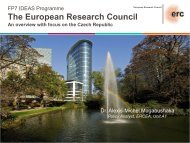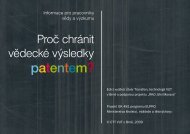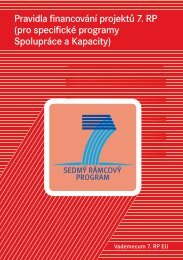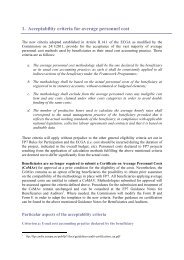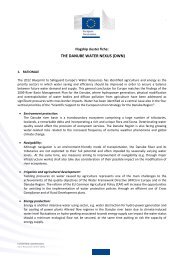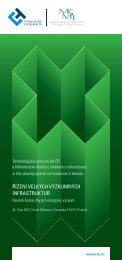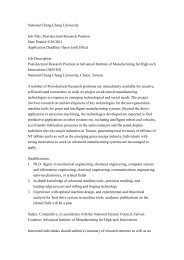Guide to Research and Innovation Strategies for Smart Specialisation
Guide to Research and Innovation Strategies for Smart Specialisation
Guide to Research and Innovation Strategies for Smart Specialisation
Create successful ePaper yourself
Turn your PDF publications into a flip-book with our unique Google optimized e-Paper software.
Step 2 - Governance: Ensuring participation <strong>and</strong> ownership<br />
At the beginning of a RIS3 design process, it is necessary <strong>to</strong> define its scope <strong>and</strong> its expected<br />
goal, with a view <strong>to</strong> ensure participation of the key ac<strong>to</strong>rs <strong>and</strong> secure ownership of the<br />
orientations defined in the strategy.<br />
With respect <strong>to</strong> the ultimate <strong>and</strong> long-term goal of the RIS3, the Vision <strong>for</strong> the future of the<br />
region should underpin the whole process: all analyses, debates, participative actions, pilot<br />
projects, etc. should be seen as participating <strong>to</strong> the long term goal identified in the Vision.<br />
Potential ac<strong>to</strong>rs relevant <strong>to</strong> the RIS3 process span from public authorities <strong>to</strong> universities <strong>and</strong><br />
other knowledge-based institutions, inves<strong>to</strong>rs <strong>and</strong> enterprises, civil society ac<strong>to</strong>rs, <strong>and</strong> external<br />
experts who can contribute <strong>to</strong> the benchmarking <strong>and</strong> peer review processes.<br />
Defining the scope of the RIS3 is crucial, since different stakeholders will have different<br />
expectations <strong>and</strong> agendas on the question at stake, often restricted <strong>to</strong> their own areas of action.<br />
Since RIS3 aims at achieving more effectiveness in all public action targeting regional<br />
trans<strong>for</strong>mation, a wide view of innovation is <strong>to</strong> be adopted. This will emphasize that innovation<br />
may occur everywhere, in different <strong>for</strong>ms, <strong>and</strong> not only in the <strong>for</strong>m of high technology<br />
development in metropolitan areas:<br />
• Including innovation in services <strong>and</strong> in the public sec<strong>to</strong>r, in addition <strong>to</strong> innovation in<br />
manufacturing sec<strong>to</strong>r which most policies target currently;<br />
• Encompassing innovation based on different types of knowledge bases, leading <strong>to</strong> different<br />
modes of innovation (Table 2): 1) the 'STI' (Science, Technology, <strong>Innovation</strong>) mode, based<br />
on analytical knowledge / basic research (science push/supply driven approach) <strong>and</strong><br />
synthetic knowledge/applied research (user driven approach), emphasizing product <strong>and</strong><br />
process innovations; <strong>and</strong> 2) the 'DUI' (Doing, Using, Interacting) mode, based on synthetic<br />
<strong>and</strong> symbolic knowledge (market/user driven), emphasizing competence building <strong>and</strong><br />
organisational innovations 25 .<br />
With respect <strong>to</strong> policy areas <strong>and</strong> organisations involved, the above wide view means that several<br />
policy areas are concerned with the RIS3, beyond the traditional science <strong>and</strong> technology <strong>and</strong><br />
economy ministries <strong>and</strong> agencies. Interministerial Committees are <strong>to</strong>ols <strong>to</strong> cope with this need<br />
<strong>for</strong> a wide conclusion of stakeholders.<br />
A RIS3 is an exercise that deals with policies developed by local, regional <strong>and</strong> national<br />
authorities (as well as EU policy - Cohesion policy <strong>and</strong> EU research policy). This multi-level<br />
dimension of policy implies that the governance mechanisms need <strong>to</strong> include stakeholders <strong>and</strong><br />
decision-makers from these various levels. It also implies that the links must be established<br />
between strategies <strong>for</strong> research (usually decided at national level) <strong>and</strong> strategies <strong>for</strong> innovation<br />
(usually under the responsibility or developed in coordination with regional authorities). They<br />
25<br />
Lorenz, P. <strong>and</strong> Lundvall, B. A. (2006) 'How Europe’s Economies Learn. Coordinating Competing Models:<br />
Different modes of innovation'.<br />
35



